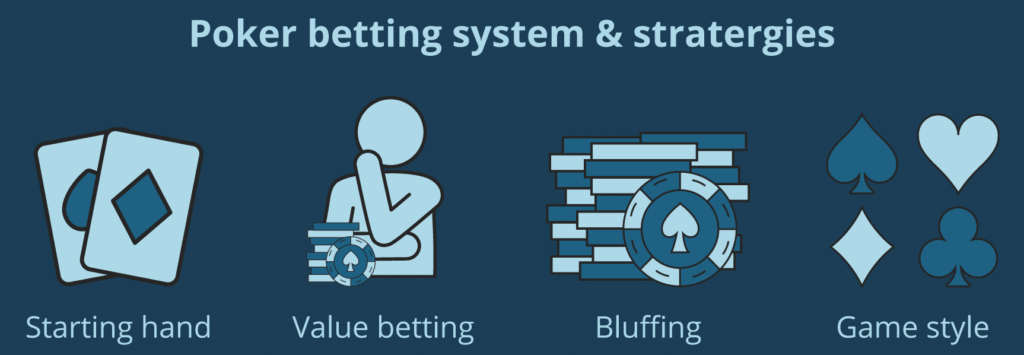Master the Rules of Poker
With so many variations of poker from which to choose can make learning the game seem daunting. However, at its core, nearly all types of poker hinge on four fundamental principles;
- Ranking – The winning hand is determined by its highest value
- Bluffing – Securing victory at poker even without the highest valued hand
- Betting – A wager of some sort is always required
- Dealer – Every game necessitates a dealer, whether or not they are an active player

The Objective
The primary goal in any poker game is to defeat your adversaries , and when real money is at stake, to seize the pot and leave the game with a larger bankroll than you initially had. Depending on the location, a game of poker can last anywhere from mere moments to several hours or even days.
Poker Hand Rules
- Royal Flush – Represents a five-card hand ranging from ten to ace all in the same suit
- Straight Flush – A five-card hand that follows a sequential order within a single suit. It can be outmatched by a higher-valued Straight Flush
- Four of a Kind – Consists of four cards of the same rank, one from each suit
- Full House – Comprises three of a kind alongside an additional pair. In contests of Full House hands, the highest three of a kind prevails
- Flush – A five-card hand containing cards of the same suit, irrespective of their order. A Flush with the highest card trump others of the same type.
- Straight – A five-card hand that consists of consecutive numbers drawn from more than one suit
- Three of a Kind – A hand that contains three of the same cards, bolstered by the two highest available cards
- Two Pairs – Consists of two groups of matching cards, backed by the single highest card present
- Pair – A combination of two cards of the same rank supported by the three highest cards in play
- High Card – The top card in a five-card hand. This is usually the weakest hand in poker
Poker games do not always assess hand value in the same manner. Poker hand rules can differ significantly; for instance: High-Hand Poker follows the ranking order mentioned above. Low-Hand Poker effectively reverses standard hand values and may implement additional ranking rules. Hi-Low Poker frequently divides the pot between both the highest and lowest hands .
Pre-Flop, Flop, Turn, River, Showdown

In the most popular poker games like Texas Hold’Em , a poker hand progresses through various phases, during which the dealer adheres to a specific sequence. These phases are referred to as Flop, Turn and River . Prior to and in between each phase, players are given opportunities to place their bets.
Pre-Flop
Recognized as the initial phase of the Poker Game, players each receive two cards, known as Hole Cards, before the first three community cards are revealed.
Flop
A Flop refers to a set of three community cards dealt face-up on the table. These 'community cards' are available for all players at the table to utilize in forming a winning hand.
Turn
After the Flop and corresponding bets, the dealer lays down a fourth card face-up on the table. This card is called the Turn.
River
The River represents the fifth and final community card dealt face-up by the dealer. Following the Turn's betting phase, players observe the River and can use this card as their last chance to improve their hands.
Showdown
In this concluding phase, known as Showdown, the player with the highest-ranking hand reveals it and claims the amount deposited in the pot.
Dealer Button
The Dealer Button is a chip or token that identifies which player acts as the ‘Dealer’ for a particular round. Generally, the Dealer Button rotates clockwise one position after each hand is completed. The primary importance of the Dealer Button lies in indicating which player places the last bet , which constitutes a significant advantage in poker.
Big and Small Blinds
The Big and Small Blinds refer to the positions occupied by players immediately to the left of the dealer. The Small Blind is adjacent to the dealer, while the Big Blind sits next to the Small Blind, making it two positions away from the dealer. These two positions are obligated to make compulsory bets .
The Big Blind usually places a bet equal to the table minimum , with the Small Blind betting half that amount . Such mandatory bets are crucial to establishing a minimum pot for the hand and provide a motivation for players not to fold prematurely.
No limit, pot limit, and limit – clarified
When it comes to poker, every variation of the game will dictate the type of pot at stake and the poker betting rules that are applicable.
- No Limit is the favored approach to playing poker, with Texas Hold ‘Em being predominantly a no limit game. In a No Limit game, players have the freedom to wager any amount in each round, which can lead to the creation of substantial pots. The magnitude of a wager can be employed tactically, generating significant excitement in the game.
- Pot Limit applies to games where a cap is set, limiting the size of bets to the total amount in the pot combined with the bets made by other players. Therefore, a player sporting a large stack of chips cannot go ‘All In’, yet retains the flexibility to greatly increase the pot’s value in a single hand. Pot Limit games necessitate different strategies compared to those in No Limit games.
- Limit or Fixed Limit poker games are viewed as the most challenging to navigate due to predetermined bet amounts that are agreed upon beforehand and can only be wagered. Fixed Limit poker games are the least favored and require ongoing calculations of poker odds.
Rule Variations
For many players, Texas Hold ’Em is synonymous with poker, and although it holds the title of most popular, it is one among many variations of the game. Poker games can largely be classified into Draw Poker, Stud Poker, and Community Card Poker with Texas Hold ‘Em being a variant within this category.
While general poker regulations commonly apply to all varieties, players may encounter certain rule deviations regarding dealing methods, hand rankings, or betting.
- Draw poker keeps all cards hidden
- Low-Ball poker traditionally reverses hand ranking values—where the lowest hand emerges as the winner.
- A poker game can fall under No Limit, Pot Limit, or Fixed Limit categories, each with distinct betting regulations.
- Certain poker variations incorporate wild cards and adapt specific rules for the game.
- Poker games can also be categorized based on table size and the maximum number of participants permitted.
Interestingly, it’s also feasible to tie in poker, which may come as a surprise to some players. Our informative video guide below elucidates the steps to take if you find yourself in this scenario at the poker table.
Types of bets in Poker
Mastering the art of betting is crucial for success in Poker . The act of placing bets is where the psychological tactics of players intertwine with strategic planning. In poker, each bet serves a specific purpose —to provoke a response, instill fear, increase the pot, or ultimately secure a win.
Among the Nine core types of bets that every poker player should understand, the Six most critical ones include value bets, continuation bets, slow plays, overbets, all-in, and pot bets . Thoughtfully selecting and utilizing these betting techniques is fundamental to achieving success in poker.
Poker odds and payouts
| Odds | Flop to Turn | Turn To River | Turn & River |
|---|---|---|---|
| 20 | 1.35:1 | 1.30:1 | 0.48:1 |
| 19 | 1.47:1 | 1.42:1 | 0.54:1 |
| 18 | 1.61:1 | 1.56:1 | 0.60:1 |
| 17 | 1.77:1 | 1.71:1 | 0.67:1 |
| 16 | 1.94:1 | 1.88:1 | 0.75:1 |
| 15 | 2.13:1 | 2.07:1 | 0.85:1 |
| 14 | 2.36:1 | 2.29:1 | 0.95:1 |
| 13 | 2.62:1 | 2.54:1 | 1.08:1 |
| 12 | 2.92:1 | 2.83:1 | 1.22: 1 |
| 11 | 3.27:1 | 3.18:1 | 1.40:1 |
| 10 | 3.70:1 | 3.60:1 | 1.60:1 |
| 9 | 4.22:1 | 4.11:1 | 1.86:1 |
| 8 | 4.88:1 | 4.75:1 | 2.17:1 |
| 7 | 5.71:1 | 5.57:1 | 2.60:1 |
| 6 | 6.83:1 | 6.67:1 | 3.15:1 |
| 5 | 8.40:1 | 8.20:1 | 3.93:1 |
| 4 | 10.75:1 | 10.50:1 | 5.06:1 |
| 3 | 14.67:1 | 14.33:1 | 7.00:1 |
| 2 | 22.50:1 | 22.00:1 | 10.90:1 |
| 1 | 46.00:1 | 45.00:1 | 22.26:1 |
House Edge in Poker
When evaluating poker odds, players participating in either a physical casino or an online game must remain vigilant about the House Edge involved.
The House Edge refers to the statistical advantage the casino holds over players when it comes to overall victories. In most poker games, the House Edge is relatively low, varying from 5.22% for Caribbean Stud Poker (the highest), 2.19% for Ultimate Texas Hold ‘Em , down to 0.46% for Video Poker (the lowest) .
How to Participate in Poker – An Overview of a Round
Here’s a detailed walkthrough of a Texas Hold ‘Em round...
- A dealer is appointed, and they distribute two cards face-down to each participant at the table.
- The player seated immediately to the left of the dealer makes a contribution to the pot known as the Small Blind .
- The next player, two positions to the left of the dealer, places a larger wager called the Big Blind .
- Moving clockwise, the remaining players make bets reflecting their confidence in the cards they've been dealt.
- The dealer then reveals the Flop, which consists of three community cards placed face-up on the table .
- The second betting round commences, beginning with the player positioned clockwise from the dealer.
- Following this, the dealer reveals the Turn, which is the fourth community card shown face-up .
- The third betting round proceeds clockwise from the dealer.
- The dealer finalizes the round by dealing the River, the fifth and concluding community card revealed face-up .
- The last round of betting takes place, continuing in a clockwise direction from the dealer's position.
- If there are two or more players still active after all betting concludes, they will reveal their cards.
- The player with the highest-ranking hand is declared the winner and takes the pot.
Conclusion
Poker is a widely enjoyed game with easy-to-understand rules, yet the various styles and formats available can sometimes complicate the decision of which variation suits you best as a player. Once you become familiar with its myriad of betting options, odds, and payouts, you can confidently choose how to engage and bet real money.
You can visit our list the best online casinos in Canada – All of these options feature diverse Poker Variants along with a range of betting choices tailored to suit every type of casino enthusiast.







